A few weeks ago, I noticed that my white female husky-collie cross, who is already very pink in her nether regions, was decidedly pinker. I asked her to come over, rolled her on her back and examined her belly. To my surprise, her entire abdomen was covered in scabs. Upon closer examination, I noticed that the scabs were also in her armpits, around the base of her tail, and also on her back. I called the other dogs over, and took a look at them as well. While it wasn’t as extensive, it was clear that they had the same problem.
It clearly was some kind of infestation, but I wasn’t quite sure which. It sort of looked like a bacterial infection, with the immature sores exuding a kind of yellow-green pus, soon followed by a blackish-colored scab. Many of these lesions had coalesced into larger patches. While it didn’t look like a demodex infestation, something akin to the pathogen I reviewed in my post on rosacea, it could be sarcoptic mange.
Sarcoptic mange. What a bad-ass sounding term. Mange certainly doesn’t sound good. Who wants to be mangey? But sarcoptic? To me it sounds like an ancient Egyptian dark magic dismemberment ritual. But in fact sarcoptic simply denotes the pathogen, a tiny arthropod in the Sarcoptes genus – the term sarcoptic being a conjugate of the medical term sarco, which means ‘fleshy’, and the Greek word koptien, meaning ‘to cut’. And to the credit of whoever named it, the term is fairly descriptive of what this little mite does, which is to burrow into the mostly hairless regions on your dog, including the abdomen and armpit region, and lay their eggs. The result is typically an intense itch, followed by scratching, biting, inflammation, secondary infection, and hair loss. It can spread extensively, cause complete hair loss, and if left untreated, can be fatal to the dog.
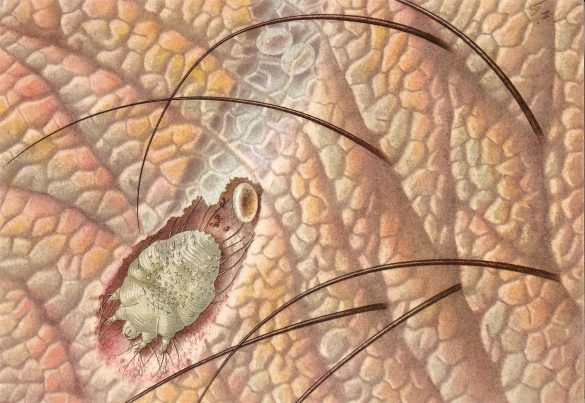
How Freya got infected I’m not really sure, but one theory is that it was from local coyotes. We live on the edge of Pacific Spirit Park, and my son had observed some mangey looking coyotes recently. Although we try to avoid it, the dogs and coyotes periodically have some interactions. It doesn’t involve much more than a bunch of wild barking and chasing before there’s a stand-off, and then everyone goes their own way. Other than that it could have been from another wild animal, perhaps a squirrel, or most likely of all, from an infected neighborhood dog. Even a brief interaction is enough for it to spread – it’s that contagious.
Even before I knew what it was, I sacrificed my electric razor to the cause, and shaved down all the affected areas – in all the dogs. Here you can see some photos of what it looked like after we shaved Freya and Sophie down. You can see just how extensive it is on Freya, both on her belly and her armpit. The last photo is of her mom Sophie, who didn’t seem to have it as bad:
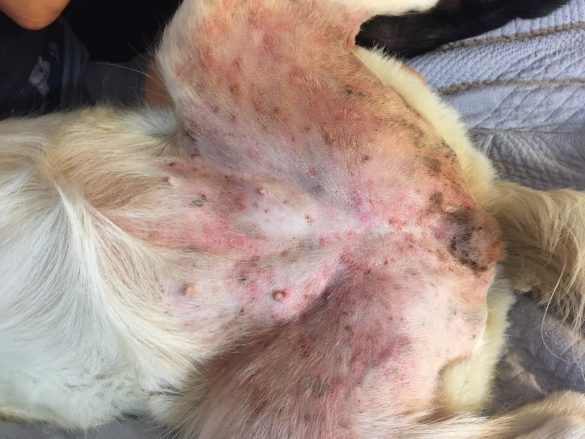
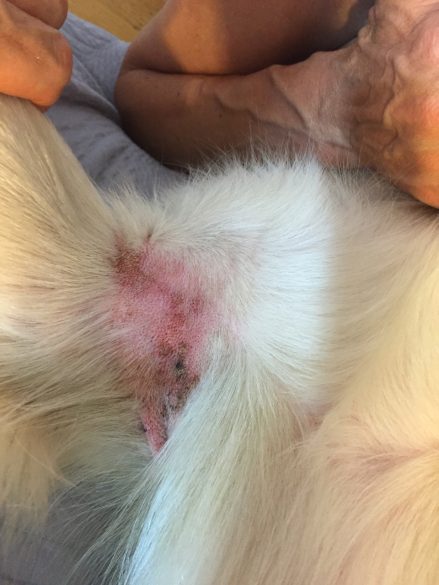
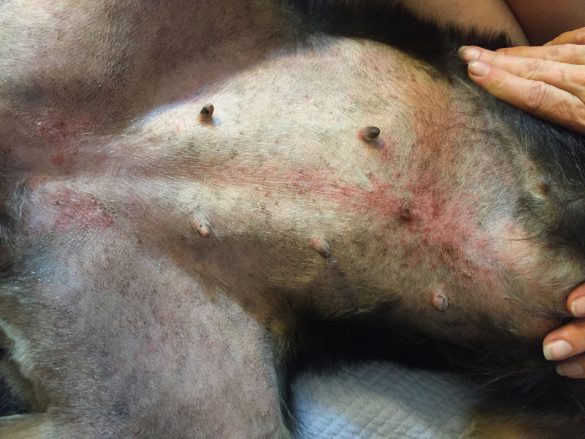
Freya was worse because she had been infected first, but she also has less hair in her nether regions than her sister thick-haired husky-like sister Bella. I pulled out my Parasite formula tincture, containing equal parts Neem leaf, Pau D’arco bark, Sweet Annie herb, immature Black Walnut hulls, and Quassia wood, and swabbed the area down. Initially I wasn’t sure what it was, but this formula is rather non-specific in action. I have patients take it with them when they travel, using it in small doses as a preventative, and in larger doses as a treatment for digestive infections. With travel, there’s always an increased risk of infection, from increased exposure, climatic factors (particularly in warm/wet regions), and also because traveling depresses vitality and immune function.
After this, we generously applied tea tree oil to all the affected areas. The dogs were not happy with this state of affairs, and initially I put the cone of shame on Freya, worried she would try to lick off the tea tree oil. After a couple days of this, however, it was clear she wasn’t going to try, and none of the dogs wanted much to do with their rear sections. All of them, but especially Freya because it was so extensive, were feeling rather depressed. At this point I could tell that she especially would just rather have the mange. While it’s one of the few essential oils that can be safely applied undiluted to the skin, tea tree oil is nonetheless highly aromatic, and for a dog’s acute sense of smell it must have been intense.
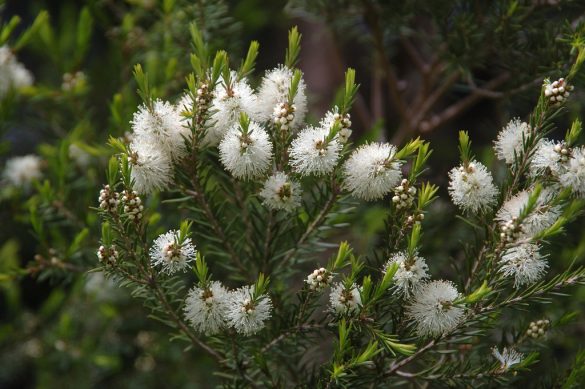
We discovered the infestation on a Friday evening (what better thing to do?), and by Monday I wasn’t quite sure if it was getting better. We gave a vet a call and enquired about treatment and cost. They were rather vague on specifics, but estimated a minimum of $300 to treat the dogs. Not being super-satisfied with this, we did some research, and weren’t pleased with what we saw. The various “dips” and lotions prescribed by vets were all highly toxic. Likewise the alternatives, such as the off-label use of ivermectin – a drug used to treat heart worm but with sarcoptic mange at much higher doses – seemed suspicious. With ivermectin in particular there is a risk of acute adverse reactions in collies, and considering that all three dogs have collie blood, it seemed best to avoid it.
After 3-4 days I wasn’t totally sure my treatment plan was working, so I made a few additions. After brushing the dogs well I applied diatomaceous earth to their coats, rubbing and brushing it deep into their fur. This is a highly fine powder of tiny fossilized diatoms – essentially mostly silica – that shreds the exoskeleton of arthropods, including mites, fleas and ticks. The only problem is that it is very drying, and it can cause drying and flaking of the skin. Fortunately, the effect is only temporary, and the diatomaceous earth can be removed later with washing.
We also procured some neem oil, something I have worked with before and know well just how sticky and gooey it is. Applying it to the dogs who were restricted to the backyard (AKA ‘the wastelands’), a place that at one time had a lot more grass, I knew that in short order all of them would become sticky, dirty mess. So I devised a simple emulsion that we could spray onto the affected areas that would hopefully be less sticky. Reusing an old garden spray bottle I made up a mixture of:
- one part tea tree oil (distilled essential oil of Melaleuca alternifolia leaf);
- one part neem oil (expressed oil from Azadirachta indica fruit);
- and, two parts water.
Leaving enough room in the bottle so I could shake the mixture up well, we attempted to apply the spray to the dogs. Very quickly they let us know they absolutely hated the smell, and it was very difficult to get them to lay still so we could apply it equally over the affected area. Bella in particular proved to be very difficult with all her squirming and we resorted to standing behind her, lifting her up by her front paws and exposing her belly. It was easier to control her and she didn’t seem to mind as much. But especially Freya absolutely hated the neem spray, particularly because she required much more of it than the others. Before spraying her she would cower, shivering in the corner, and then after she would run away to hide. For the dogs, the smell of the neem oil seemed as bad or if not worse than the smell of skunk.
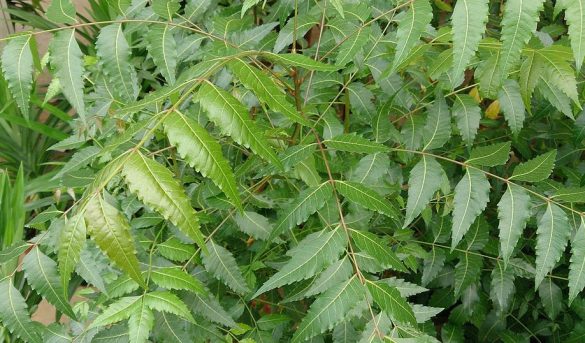
After applying this spray for two weeks every day, once a day, we could clearly see that there were no more new lesions forming, and the older ones were healing well. Sophie both had a little scratch-like lesion that looked like a couple mites might be hatching, but Freya and Bella looked totally clean. The following day I spent some time brushing them, and then gave them all a good shampoo, to remove the neem oil smell. Then because the diatomaceous earth had really dried out their skin, I slathered them in coconut oil and let them bake in the grass in the afternoon sun. Over the next few days I have them a couple more baths to remove the excess coconut oil.
We continued to watch for any new hatchings, and given the 17-21 day life cycle of this little mite, dabbed any suspicious looking lesions with tea tree oil. It became very clear just how effectively the lipid-soluble antimicrobial compounds in both the tea tree and neem oils penetrated the dogs’ skin to the mites and their eggs. All in all, the medication to treat all the dogs was about $80, and I have lots of ti-tree and neem oil left over for any touch-ups or future outbreaks.
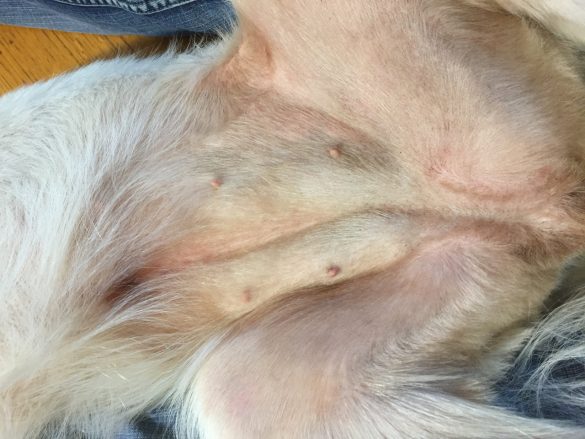
Oh, and as for us humans, yes we can acquire these mites but unlike our human-specific variant of scabies (Sarcoptes scabiei var. hominis), dog scabies can’t reproduce on our skin. Nonetheless, they can still burrow into the skin and it seemed that after exposure both my daughter and I had a couple red itchy spots. She had them on her hands, and I had a couple spots on my legs. Fortunately a generous dab of tea tree oil applied topically 1-2 times was all that was required to kill the mites and deal with the itch.
So there is a little story about sarcoptic mange, and how to treat it without poisoning yourself, your dog, or the environment, and save some money in the process.







I have used Neem oil a lot on dogs, mainly for fleas. I use a similar mix to what you describe of oils and water, plus I add a small amount of biodegradable detergent to emulsify the oils.
For fleas I also use Lemon grass oil and Cedarwood plus the Neem. I used to spray my dog’s legs (and mine) just before going out when the fleas were very bad. It works!
I am dealing with what I believe is sarcoptic mange on my 2 shih tzu dogs……It’s is miserable! I was about to put tea tree oil on Felix (the worse of the 2) but before I did, thought I read to see if it’s toxic to dogs…..My search said it is unless seriously diluted….I’m not sure about the dilution. I wonder if you know?
Thanks for sharing this knowledge. I have an infestation on mange at my house. I will try this as I have try the borax peroxide treatment. When you say parts. What is that in measures. Teaspoons tablespoons cups. I’m not clear.
Thanks.
Tammye